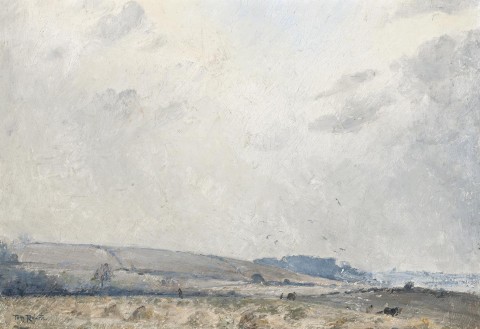A WINDY DAY, DORSET, c.1921
TOM ROBERTS
oil on canvas on wood panel
30.5 x 44.5 cm
signed lower left: Tom Roberts.
bears inscription verso: Landscape in Dorset England. Tom Roberts / PROPERTY OF W.G. BUCKLE
William Grant Buckle, Sydney
Thence by descent
Private collection, Perth
Sotheby's, Melbourne, 21 November 2006, lot 20
Private collection, Melbourne
Deutscher~Menzies, Sydney, 25 March 2009, lot 62
Private collection, USA
Private collection, Melbourne
Tom Roberts Retrospective Exhibition, National Art Gallery of New South Wales, Sydney, November 1947 – January 1948; National Gallery of Victoria, Melbourne, February – March 1948, cat. 75 (lent by Mrs W.G. Buckle)
John Brackenreg at Wales House Gallery, Sydney, June 1962, cat. 36
Topliss, H., Tom Roberts 1856-1931: A Catalogue Raisonné, Oxford University Press, Melbourne, 1985, cat. 525, vol. I, p. 199; vol. II, pl. 213 (illus.)
Tom Roberts’ A Windy Day, Dorset, c.1921 belongs to a special group of paintings full of atmospheric skies exploring wondrous effects, of clouds pierced by shafts of light, tossed high by the winds, or in the stately calm of an English late afternoon. In Storm at Sea, 1907, a dramatic view off the Norfolk coast, and The Harrow on the Hill, c.1910 – 12, (both in the collection of the Art Gallery of New South Wales, Sydney), the influence of the late paintings of J. M. W. Turner and John Constable can be readily felt. This passionate response to the landscape continued through his Dorset paintings of the early twenties and on to his later works of the Dandenong Ranges. Settled in Australia, he was so captivated by the skies that he painted a number of studies of them, one particularly fine example, Cloudscape, c.1923, being in Canberra’s National Gallery of Australia.1 Roberts had written from his home in the Dandenongs: ‘Up here are the most wonderful clouds; one goes at ‘em and is almost afraid to look next day at the result for fear of disappointment – High piled up cumuli reared up over a shadowed hill are inspiring’.2 It is the late Dorset paintings, however, that call for special attention. For it is here that we find Roberts capturing the character of the English landscape with that special perception and feeling given to one making a heartfelt farewell to the place of their birth.
Born in 1856 in Dorchester, Dorset, where his father Richard was editor of the Dorset County Chronicle, Roberts spent his early years there. It was not until 1868, following the death of Richard Roberts, that the family migrated to Australia. Yet, the call of his birthplace was so strong that Roberts visited Dorset during his student years at London’s Royal Academy Schools. His Churchyard at Shillingstone (Deutscher and Hackett, Sydney, 28 August 2013, lot 78) was painted in north Dorset in 1884. Much later, and after many years living in England, Roberts and his wife finally decided to return and settle in Australia. ‘Shortly before leaving England’, Roberts tells us, ‘we spent some memorable weeks down in Thomas Hardy country. The Dorset villages are ideal subjects for an artist. We went along the south and west of England, and I made many sketches of those beautiful types of scenery’.3
A Windy Day, Dorset is from this time, blending Roberts’ characteristic realism with a poeticism inspired by nostalgia in a moving expression of attachment to the countryside. The grandeur of the sky, filled with the atmospheric effects of high wind and clouds, is in gentle harmony with the view across the fields and the nobility of working the land, imaged in the small figures of farmers and their horses ploughing the fields of promise. The air is filled with diffused light, colours of soft harmonies, as birds rise on the wind.
1. See Gray, A., Tom Roberts, National Gallery of Australia, Canberra, 2015, pp. 50 – 51, 272 – 273, 300 – 301
2. Roberts, T., letter to Major Bertodano, 20 November 1924, Tom Roberts biographical file, Art Gallery of New South Wales Library, Sydney, quoted in ibid., p. 300
3. Roberts, T., quoted in ‘Artist and Humorist. Return of Mr. Tom Roberts’, Register, Adelaide, 17 February 1923, p. 13
DAVID THOMAS
